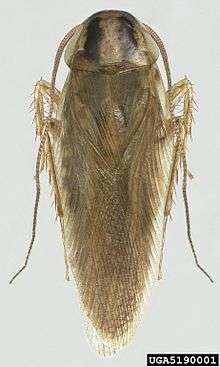Blattella asahinai
| Blattella asahinai | |
|---|---|
 | |
| Asian cockroach: adult specimen | |
| Scientific classification | |
| Kingdom: | Animalia |
| Phylum: | Arthropoda |
| Class: | Insecta |
| Order: | Blattodea |
| Family: | Blattellidae |
| Genus: | Blattella |
| Species: | B. asahinai |
| Binomial name | |
| Blattella asahinai Mizukubo, 1981 | |
Blattella asahinai, the Asian cockroach is a species of cockroach that was first described in 1981 from insects collected on Okinawa Island, Japan.[1]
Description
The Asian cockroach is nearly identical to the German cockroach (Blattella germanica) except for a few minor morphological differences. Like the German cockroach, it is about 1.6 cm (0.63 in) long, is tan to brown in color, and has wings. However, its wings are longer than the German cockroach, and there is a difference between a groove in the abdomen between the two species. There are other differences. The quickest way to tell the difference between the two species is that the Asian cockroach is a strong flyer (almost like a moth) and is attracted to light, unlike the German cockroach.[1] This species tends to prefer the outdoors, whereas the German cockroach prefers living indoors.

Distribution
Blattella asahinai is found in tropical and subtropical climates, and was first identified in the United States in 1986 in Lakeland, Florida. It has since expanded throughout much of Florida and is spreading into other southern states. In addition to Florida, it is reported in Alabama, Georgia, South Carolina, and Texas.[1] Its population reaches its zenith in late August and declines rapidly with the onset of cool weather (Snoddy and Appel 2007). During adverse weather conditions such as cold weather or dry conditions, the Asian cockroach will burrow down into the leaf litter (Snoddy and Appel 2007).
Beneficial insect
According to entomologist Bob Pfannenstiel (Beneficial Insects Research Unit, Weslaco, Texas), this omnivorous species also feeds, under certain conditions, on the eggs of lepidopteran pests of annual crops. Asian cockroaches ventured west into Texas in 2006, and became the most common predator of bollworm eggs in the state's Rio Grande Valley region. The bollworm threatens cotton, soybean, corn and tomato crops.[2]
References
- 1 2 3 Richman D. Asian cockroach. Blattella asahinai Mizukubo. Featured Creatures. March 2008. Last accessed 2008-08-08
- ↑ US Department of Agriculture (2008, January 7). Asian Cockroaches Could Aid Texas Growers. ScienceDaily. Retrieved March 6, 2008
| Wikimedia Commons has media related to Blattella asahinai. |
External links
- Asian cockroach on the UF / IFAS Featured Creatures Web site.